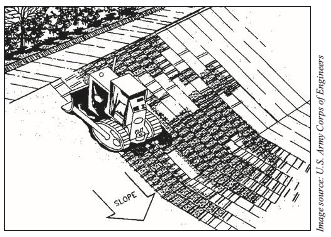Site Preparation
Table of Contents
Site preparation enhances seed-to-soil contact, helps ensure proper planting depth, and can even provide erosion control. Many roadsides that need to be seeded already have bare soil because vegetation was removed as part of the regrading work associated with a road project or because a ditch cleanout project removed silt that had runoff from an adjacent field. Whether existing vegetation needs to be removed or not, additional preparation can increase planting establishment. Before working on a site:
- Walk the site looking for gullies, culverts, logs, stones, stumps, and other hazards.
- Check with utility companies before discing (i.e., breaking up or disturbing the soil using a disc harrow).
- If weed growth is excessive, mow and disc to break and mix the stubble into the soil, if possible.
- Calculate the size of the area to be planted and the amount of seed it will take (see “Chapter 4: Native Seed” for more information on seeding rates).
- Size up the watershed and the site’s erosion potential (see “Chapter 6: Erosion Control” for more information).
Seedbed Preparation for Drill Seeding
- Ideal seedbeds are friable, firm, and smooth.
- To reduce erosion, do not smooth the site until just before planting.
- Relatively level sites can be worked with a disc, chain-tooth harrow, or similar equipment.
- To avoid creating excessive dirt clods, do not work the site while it is too wet.
- Cultipacking (i.e., breaking up and leveling a seedbed) can help firm the seedbed and reduce clods.
Seedbed Preparation for Hydroseeding

- Seedbeds can be left rougher to reduce erosion.
- Steep slopes can be ripped with a wide-track dozer.
- Using dozer treads to create directional tracking (see Figure 5.1) can interrupt water flow.
- Using a dozer, create grooves perpendicular to the slope to interrupt water flow.
Heavily Compacted Soils
- Try to till the site to a depth of three inches.
- A heavy disc harrow might be necessary to break up soil that is especially dense and difficult to till.
- Some sites may need to be worked with long bulldozer tines (a ripper attachment on a bulldozer) to break up compacted soil that is too dense for standard bulldozer blades.
Roadside Real Talk
Insights from Roadside Managers and Other Professionals
Getting your seeds to grow is a priority. Try to get good seed-to-soil contact when possible.
—Joe Kooiker, Story County, 2024
For hydroseeding, we prefer the site to be rough and a little soft. We seed immediately after the construction equipment has left, with no additional seedbed preparation. The rough texture keeps the seed in place, and the softness allows for better root penetration. However, for drill seeding, firmness is the most important factor. It is easy for seed to get buried too deep in soft seedbeds, either during or post planting.
—Doug Sheeley, Dallas County, 2024


